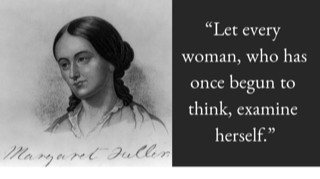Midsummer, I received a letter (yes, in the mailbox) from my son. Inside the envelope, I found an article cut from the July 27, 2020 edition of “The New Yorker”. A hand written post-it-note was attached – “Mom, with your recent interest in women’s rights (re: PBS Suffragettes, etc.), I think you will also enjoy this piece from The New Yorker.” The article, entitled “An unfinished Woman – The desires of Margaret Fuller”, started me on a search to learn more about Fuller as a 19th century ground breaker for woman.

I was intrigued by the reference in Eden’s Outcasts to Margaret Fuller being a part of the Boston area transcendentalist experience. At the same time the Alcott family was exchanging ideas with Emerson and Thoreau, Fuller was right there with them with her ideas on changing conventional thought – “the female public intellectual”. So I set out to read Margaret Fuller: A New American Life by Megan Marshall.
Margaret’s early education was provided by her father, Timothy Fuller. He was determined to give her an education equal to any man’s. Young Oliver Wendell Holmes, at age eleven, realized, ten year old, Margaret’s written work was superior to his own. For higher education, no American college had yet opened its doors to women, however Margaret would not allow “circumstance” to erode her “enthusiastic confidence in the future”.
“They can conquer who believe they can.”
“Possunt Quia posse videntur”
Virgil”s Aeneid
Being independent was a Fuller family trait. Her paternal grandfather refused to vote in favor of the United States Constitution because it had not banned slavery. At nine years old, Sarah Margaret Fuller decided and insisted, “I do not like Sarah, call me Margaret only, pray do.” At fourteen, she confided, “I am determined on distinction.” At fifteen, she confronted the inevitable difference between her future prospects and those of a similarly talented and ambitious boy. At sixteen, unable to attend nearby Harvard, she pursued a self imposed curriculum of her own making. She trained herself in several modern languages and read world literature. By the time she was in her 30’s she had earned a reputation as the best read person, male or female, in New England.
In 1835, when Margaret was 25, her father died of cholera. She vowed to step in as head of the family, supporting her mother and siblings. First she taught at Bronson Alcott’s Temple School. While there she stayed with the Emerson’s, and in 1837 moved on to the Greene Street School, with Hiram Fuller (not a relative) and Emerson, in Providence, Rhode Island. In 1839, Emerson offered Margaret a position as editor of “The Dial”, his transcendentalist journal. At this same time, she began her “Conversations”, group discussions among young women intended to compensate for the lack of formal education offered to young women. The classes included the likes of Julia Ward (to become Julia Ward Howe) and Elizabeth Cady Stanton (before moving to Seneca Falls). Up to this point, Megan Marshall has presented, in historic detail, how formative Margaret Fuller’s New England upbringing was on her arrival to her thirties.

In my opinion, this is where and when the book really takes off. Margaret leaves New England and the adventures begin. In her own words, she was a Yankee “born to rove”. In 1843, her first journey took her by covered wagon to the edge of the American west, to Illinois’ Great Lakes region. Everywhere, she is alert to the plight of Native Americans and she observes that frontier wives do not fare well. She returned to New York where Horace Greeley offered Margaret a position as literary editor for the New York Tribune. In 1845, she wrote her seminal work, “Women in the Nineteenth Century“. She questioned, If only women would “rouse their latent powers”, and “assume their inheritance.”1 Fuller ended with a forward looking call for the woman who will teach women to be individuals. By 1846, The New York Tribune was ready to send Fuller to Europe, specifically England and Italy, as its first female foreign correspondent.
Here she found what she had spent a lifetime preparing to discover. First, in London she met and became acquainted with Giuseppe Mazzini, an Italian politician, journalist, activist for the unification of Italy and spearhead of the Italian revolutionary movement. Margaret’s journey takes her to Rome, where she met and married Giovanni Angelo Ossoli, a young soldier fighting in the revolution to unite a republic of Italy. Mazzini’s young republic was short lived, as the Pope appealed to Catholic countries for help, and the French army crushed the new republic. Margaret, Giovanni and their young son, Nino, fled Italy. The family boarded the Elizabeth, a sailing cargo ship with only a handful of passengers.
A steady wind drove the Elizabeth westward across the Mediterranean toward Gibraltar and the broad Atlantic bound for New York. Off Fire Island, in a wind driven gale, The Elizabeth ran aground on a treacherous shoal and sank. Margaret and her family never reached home. Margaret and Giovanni’s bodies were never recovered. Nino was buried in Mount Auburn Cemetery in Cambridge, Massachusetts, under a cenotaph to Fuller and her husband, Ossoli. The inscription reads:
by birth a child of new england
by adoption a citizen of rome
by genius belonging to the world
Marshall’s Fuller overwhelms the reader just as Fuller herself overwhelmed everyone she met. In Margaret Fuller’s own words, “Where I make an impression it must be by being most myself.” Reading this book and discovering an amazing life was a gift.
1Woman in the Nineteenth Century. Fuller, Margaret.
